<< Previous | Displaying results 5851-5900 of 6769 for "" | Next >>
A view of the quarry at the Mauthausen concentration camp, where prisoners were subjected to forced labor. Austria, 1938-1945.

Soviet prisoners of war arrive at the Majdanek camp. Poland, between October 1941 and April 1944.
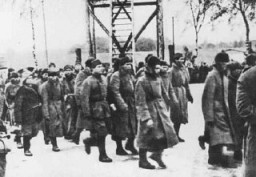
Forced labor in a workshop in the Monowitz camp, part of the Auschwitz camp complex. Poland, between 1941 and January 1945.

Chart indicating the workforce of the Auschwitz-Monowitz camp by category and nationality of inmates. Poland, January 16, 1945.

Clandestine photograph, taken by a German civilian, of Dachau concentration camp prisoners on a death march south through a village on the way to Wolfratshausen. Germany, between April 26 and 30, 1945.
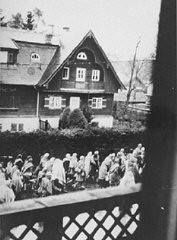
Piles of prayer shawls that belonged to Jewish victims, found after the liberation of the Auschwitz camp. Poland, after January 1945.
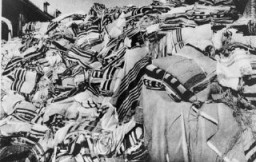
Scene after the liberation of the Auschwitz camp: a warehouse of clothes that belonged to women who were murdered there. Auschwitz, Poland, after January 1945.
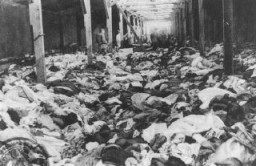
African American soldiers of the US Army escort German civilians through a site where camp prisoners were massacred during a death march from Buchenwald. Such tours forced Germans to recognize the crimes committed by the SS. Near Nammering, Germany, 1945.
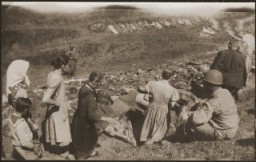
Former prisoners of Wöbbelin, a subcamp of Neuengamme, are taken to a hospital for medical attention. Germany, May 4, 1945.
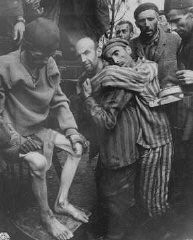
Corpses found when US troops liberated the Gusen camp, a subcamp of the Mauthausen concentration camp. Austria, after May 12, 1945.
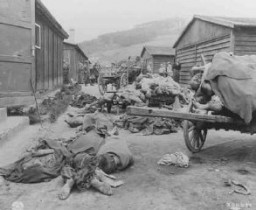
A US soldier tends to a former prisoner lying among corpses of victims at the Dora-Mittelbau concentration camp, near Nordhausen. Germany, after April 10, 1945.
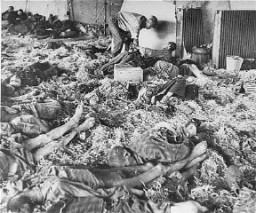
US troops view bodies of victims of Kaufering IV, a Dachau subcamp in the Landsberg-Kaufering area. Germany, April 30, 1945.
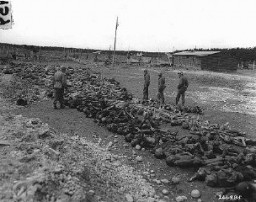
After the occupation of Odessa, Ukrainian Jews wait to register. Odessa, Soviet Union, October 22, 1941.
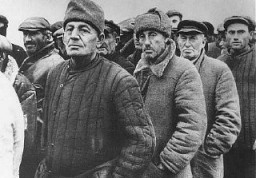
Reinhard Heydrich, chief of the SD (Security Service) and Nazi governor of Bohemia and Moravia. Place uncertain, 1942.
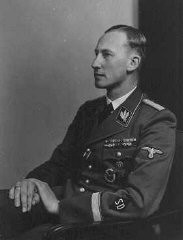
Two survivors prepare food outside the barracks in Dachau, Germany, May 1945. This image is among the commonly reproduced and distributed images of liberation. These photographs provided powerful documentation of the crimes of the Nazi era.
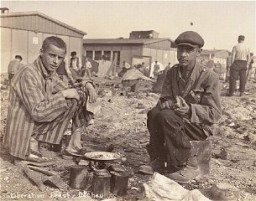
A US soldier on an inspection tour of Buchenwald poses for a photograph beside a wagon laden with corpses. The soldier is probably a member of the Headquarters and Service Company, 183rd Engineer Combat Battalion, 8th Corps, US 3rd Army, which arrived at Buchenwald on April 17, 1945, several days after the camp's liberation.
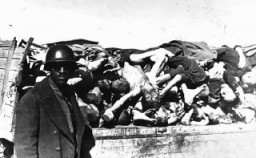
Members of the 12th Armored Division, which included African American platoons, await their orders. Germany, April 1945.
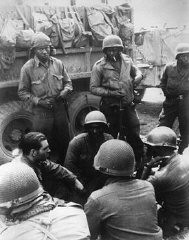
African American soldier Warren Capers was recommended for a Silver Star for his actions during the Allied invasion of France. He and his medical detachment aided more than 330 soldiers. France, August 18, 1944.
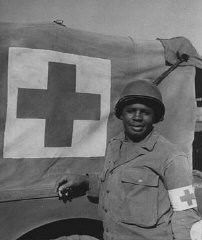
African Americans were among the liberators of the Buchenwald concentration camp. William Scott, seen here during training, was a military photographer and helped document Nazi crimes in the camp. Alabama, United States, March 1943.
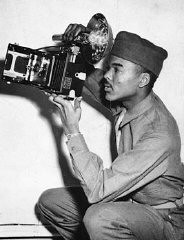
Father Charles Coughlin, leader of the antisemitic Christian Front, delivers a radio broadcast. Detroit, United States, March 11, 1935.
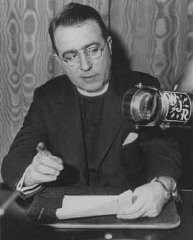
Father Charles Coughlin, leader of the antisemitic Christian Front, delivers a radio broadcast. United States, February 4, 1940.
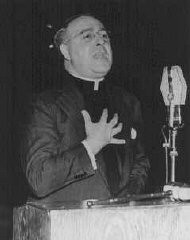
The Aliyah Bet ("illegal" immigration) ship Parita, carrying 850 Jewish refugees, lands on a sandbank off the Tel Aviv coast. The British arrested the passengers and interned them at Atlit detention camp. Palestine, August 21, 1939.
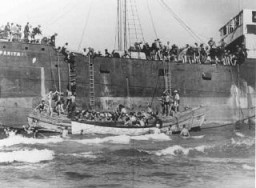
Aliyah Bet ("illegal" immigration) ship Tiger Hill, carrying Jewish refugees from Europe, lands in Tel Aviv, Palestine. Jewish residents of Palestine greet the ship. September 1, 1939.
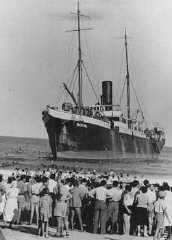
Jewish refugees on board the Aliyah Bet ("illegal" immigration) ship Atrato. The ship was caught by the British off the coast of Jaffa, Palestine, and escorted to Haifa port. July 17, 1939.
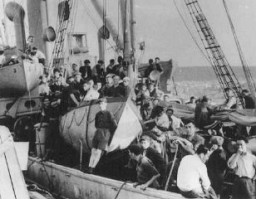
Rabbi Michael Dov Weissmandel, leader of the Working Group (Pracovna Skupina), a Jewish underground group devoted to the rescue of Slovak Jewry.
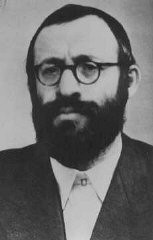
Jewish refugees line up to receive food provided by the American Jewish Joint Distribution Committee (JDC) after the war. Shanghai, China, 1945-1946.
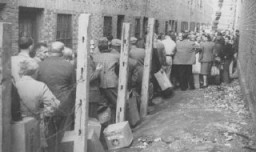
Scene during the Evian Conference on Jewish refugees. On the far right are two of the US delegates: Myron Taylor and James McDonald of the President's Advisory Committee on Political Refugees. Evian-les-Bains, France, July 1938.

British Zionist leader Norman Bentwich (left) with Henri Berenger, French delegate to the Evian Conference on Jewish refugees. Evian-les-Bains, France, July 1938.

Myron Taylor, US delegate to the Evian Conference, pleads for the establishment of an intergovernmental committee to facilitate Jewish emigration. Evian-les-Bains, France, July 15, 1938.
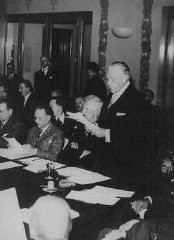
United States delegate Myron Taylor delivers a speech at the Evian Conference on Jewish refugees from Nazi Germany. Evian-les-Bains, France, July 15, 1938.
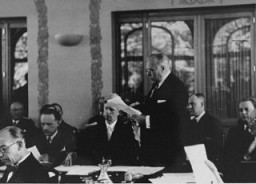
Postcard showing Evian-les-Bains, a French resort of Evian on Lake Geneva, at the time of the 1938 Evian conference on refugees.
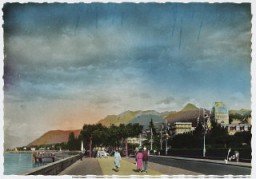
Barracks for prisoners at the Flossenbürg concentration camp, seen here after liberation of the camp by US forces. Flossenbürg, Germany, May 5, 1945.
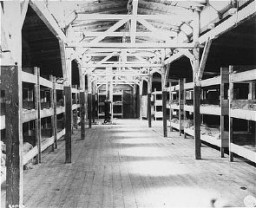
View of the Flossenbürg concentration camp after the liberation of the camp by US forces. Flossenbürg, Germany, 1945.

Execution site in the Flossenbürg concentration camp, seen here after liberation of the camp by US armed forces. Flossenbürg, Germany, after May 1945.
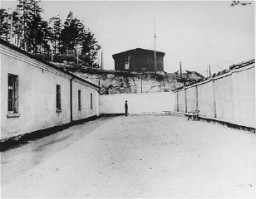
After the liberation of the Flossenbürg camp, a US Army officer (right) examines a crematorium oven in which Flossenbürg camp victims were cremated. Flossenbürg, Germany, April 30, 1945.

Entrance gate to the Riga ghetto. This photograph was taken from outside the ghetto fence. Riga, Latvia, 1941-1943.
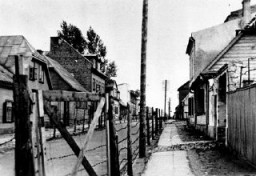
Entrance to the Riga ghetto. Riga, Latvia, 1941–43. During the Holocaust, the creation of ghettos was a key step in the Nazi process of separating, persecuting, and ultimately destroying Europe's Jews.
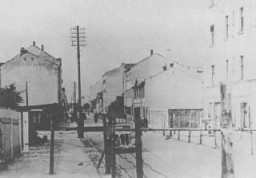
Jewish families with bundles of belongings during deportation from the Kovno ghetto in Lithuania to Riga in neighboring Latvia. Kovno, Lithuania, 1942.
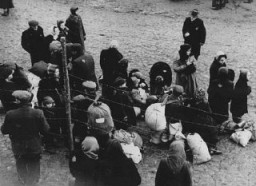
14-year-old Sara Bialovadska, imprisoned in the Kaiserwald concentration camp near Riga. Latvia, 1943.

Lithuanian militiamen in Kovno round up Jewish women. Kovno, Lithuania, June-July, 1941.
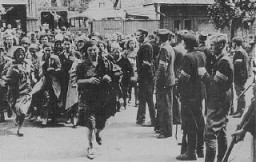
Crowd views the aftermath of a massacre at Lietukis Garage, where pro-German Lithuanian nationalists killed more than 50 Jewish men. The victims were beaten, hosed, and then murdered with iron bars. Kovno, Lithuania, June 27, 1941.
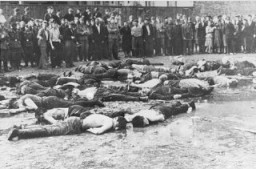
This photograph shows the Rudnicki Street entrance to the Vilna ghetto. The signs on the fence claim there is danger of contagion and prohibit the bringing of food or wood into the ghetto. Photograph taken in 1941–42.
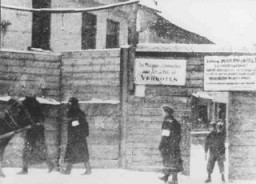
Lithuanian collaborators guard Jews before their execution. Ponary, Lithuania, June–July, 1941.
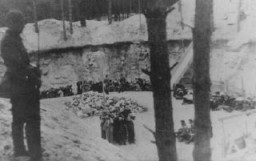
Jews at the railroad station before deportation. Puchov, Czechoslovakia, March 1942. (Source record ID: E39 Nr.2447/8)
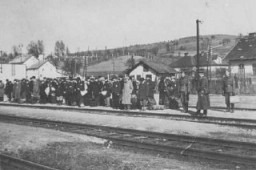
Scene during the deportation of Macedonian Jews by Bulgarian occupation authorities. Skopje, Yugoslavia, March 1943.
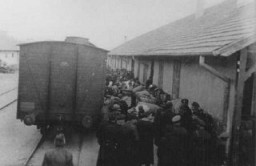
A building in Rome, Italy, used as Gestapo (secret state police) headquarters during the German occupation. This photograph was taken after US forces liberated the city. Rome, Italy, June 1944.
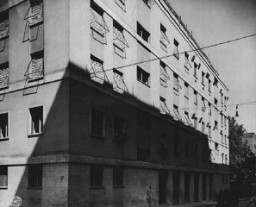
Class photograph of students at the San Leone Magno Fratelli Maristi boarding school in Rome. Pictured in the top row at the far right is Zigmund Krauthamer, a Jewish child who was being hidden at the school. Rome, Italy, 1943–44.
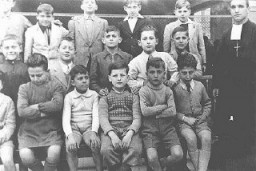
A cheering crowd greets Adolf Hitler as he enters Vienna. Austria, March 1938. After a prolonged period of economic stagnation, political dictatorship, and intense Nazi propaganda inside Austria, German troops entered the country on March 12, 1938. They received the enthusiastic support of most of the population. Austria was incorporated into Germany the next day.
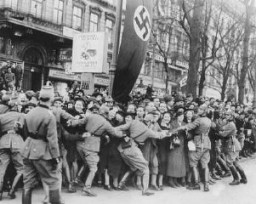
A Jewish man deported from Vienna, Austria, performs forced labor in the Opole Lubelskie ghetto. Poland, date uncertain.

View of the Gusen camp, which became a subcamp of the Mauthausen concentration camp. This photograph was taken after the liberation of the camp. Gusen, Austria, May 1945.
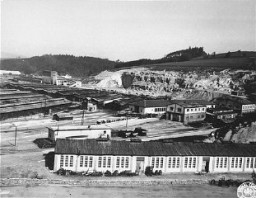
We would like to thank Crown Family Philanthropies, Abe and Ida Cooper Foundation, the Claims Conference, EVZ, and BMF for supporting the ongoing work to create content and resources for the Holocaust Encyclopedia. View the list of donor acknowledgement.